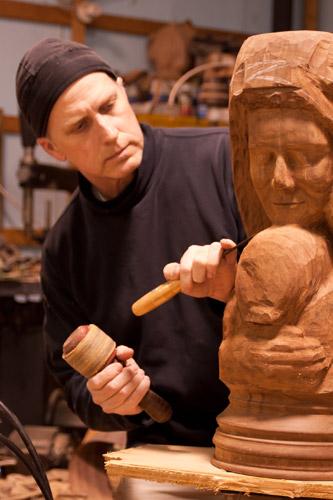

Name: George Hoelzeman
Parish: St. Mary Church
City: Saint Vincent
Family: Wife Cheryl and daughters, Anja and Heidi
Why you want to know George: From a single set of Stations of the Cross plaques carved for a priest friend, George has grown into one of the most sought-after liturgical artists in the country. Largely self-taught, his wood carving and design are on display in churches around the country. In each, the Morrilton native who once discerned a vocation to monastic life addresses the most familiar of images — Jesus Christ — revealing his life, love and promise in ways that are thought-provoking.
IN HIS OWN WORDS
Arkansas Catholic’s theme this year is “Tools for Discipleship.” Do you consider your art a means to discipleship for others?
Yes. I mean the icon, the image is always a tool for discipleship. It’s sacramental; it indicates grace. It connects us with the invisible. The Eastern church describes it as a window into heaven or a mirror of the divine. And once it’s done, it’s not mine anymore, it’s the community’s, it’s used by the people, it’s used by God to communicate one to the other. It’s a meeting place, it’s a sacred focal point and it has its own life and existence beyond anything I do.
There’s a certain way we expect Christ to look. Given those limitations, is it a struggle for you to come up with a fresh perspective on such a recognizable figure?
You just took the lid off a massive and very, very important issue. You need a comfort level with sacred art because if it’s too shocking, if it’s too different, it pushes people away. But at the same time, if it’s too routine, if it’s too much of what we’ve always seen we blip right over it. It’s like people living in Colorado and seeing the mountains every day — they forget how awesomely majestic they are.
One way you balance that is focusing on one small detail to represent the scene. For Jesus being stripped of his garments, you carved a hand dropping dice and where he’s nailed to the cross, you carved the hammer coming down. It’s very powerful.
By focusing on these little elements — on faces, on hands — it kind of makes the viewer no longer a viewer but a participant. And it makes you think, I’m familiar with this but what is actually going on in this particular moment? Like the rolling of the dice — we’ve all heard the reading, “For my garments they cast lots.” But by focusing just on that hand and that dice and the garment in the background, it becomes a connection to a human event with divine implications. It awakens you, it forces you to think about this.
Does the species of wood you select for a given project lend itself to that story?
It can be. One interesting thing that is coming up more and more frequently is communities wanting domestic hardwoods and avoiding exotics because of environmental issues. This increasing awareness of environmental issues and the morality of caring for the environment is an interesting part of an emerging spirituality of the Church that’s been reflected, especially, by the last two popes.
There was a period where many churches took out the very intricate, ornate appointments and made sanctuaries so sparse they looked like community rooms. It was the Period of the Great Darkness. (Laughs) The horrors, the horrors of the ‘70s. Yes, I remember it painfully well.
Describe your style and ability to bring these elements together.
That’s an interesting question. I am one who loved the old, ornate baroque altars. The style that turned me on to art history is the style of Bernini’s work in Rome and the imperial baroque in Germany, a lot of that stuff. Love it, love it, love it.
Please read our Comments Policy before posting.
Article comments powered by Disqus St. Timothy winner recommends adoration to other teens
St. Timothy winner recommends adoration to other teens
 Catholic school coaches: Best of friends and of rivals
Catholic school coaches: Best of friends and of rivals
 St. Vincent de Paul School breaks ground on expansion
St. Vincent de Paul School breaks ground on expansion
 Father James H. Burnie, CSSp, died Aug. 3 at 92
Father James H. Burnie, CSSp, died Aug. 3 at 92
 Artist: Divine Mercy work is ‘particularly meaningful’
Artist: Divine Mercy work is ‘particularly meaningful’
 Winning directory photo honors Our Lady of Guadalupe
Winning directory photo honors Our Lady of Guadalupe
 St. Paul says: How does the Bible define love?
St. Paul says: How does the Bible define love?
 6 steps to getting married in Diocese of Little Rock
6 steps to getting married in Diocese of Little Rock
 Most frequently asked questions on Catholic marriage
Most frequently asked questions on Catholic marriage
 St. Joseph a model of solidarity with immigrants
St. Joseph a model of solidarity with immigrants
 Two gifts after Jesus’ death: Virgin Mary and Eucharist
Two gifts after Jesus’ death: Virgin Mary and Eucharist
 Why we have an altar, and not just a communion table
Why we have an altar, and not just a communion table
 Pope: Wars should be resolved through nonviolence
Pope: Wars should be resolved through nonviolence
 Living relationship with Jesus Christ in the Eucharist
Living relationship with Jesus Christ in the Eucharist